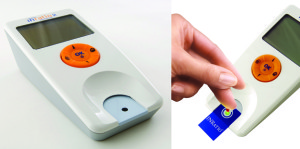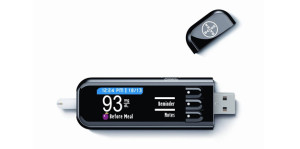Innovative designs promote in vitro home-testing medical diagnostic devices that could impact the work done in clinical laboratories
With greater frequency, new diagnostic technologies make it possible to move medical laboratory tests out of the traditional central lab facility and closer to the patient—including patient home self-testing. Even as this happens, engineers and designers are delivering elegant, well-designed devices designed for use in clinical laboratories as well as in near-patient settings.
Evidence of this trend comes from the most recent winners in the annual contest known as the Medical Device Excellence Awards (MDEA). In this year’s contest, two of the products receiving awards were medical laboratory test devices that were deemed to be innovative solutions to improve the lab testing process.
This contest intends to “recognize significant advances in medical product design and engineering that improve the quality of healthcare delivery and accessibility.” The competition was first held in 1998 and is sometimes described as the “Oscars” of the medical device. Receiving an MDEA medal offers validation, publicity, and a host of other benefits.
17 Years of MDEA Awards
The MDEA jury has been recognizing inventors, designers, and suppliers of what it considers to be “compelling and innovative” medical devices since 1998. They represented a plethora of categories including:
• In Vitro Diagnostic Products and Systems
• Over-the-Counter and Self-care Products
• Surgical Equipment, Instruments, and Supplies
• Rehabilitation and Assistive-technology Products
• Radiological and Electromechanical Devices
• Medical Product Packaging, Graphic Instructions, and Labeling Systems
• Implant and Tissue-replacement Products
• General Hospital Devices and Therapeutic Products
• Drug-delivery Devices and Combination Products
• Dental Instruments, Equipment, and Supplies
• Critical-care and Emergency Medicine Products
In 2014 and 2015, several of the winners were laboratory diagnostic devices. They included:
• Cologuard (Gold Winner 2015): A test manufactured by Exact Sciences Corp. for colorectal cancer (CRC) screening and compliance.
• BacterioScan 216R Laser Microbial Growth Monitor (Silver Winner 2015): A test manufactured by BacterioScan, Inc. that detects urinary tract infections in patient specimens in less than 90 minutes.
• AtomoRapid HIV (1&2) integrated rapid antibody test (Gold Winner 2014): Manufactured by Atomo Diagnostics Pty Ltd., the integrated rapid test detects HIV 1&2 in blood specimens.
• HYBRiD-XL fully automated continuous access analyzer (Bronze Winner 2014): Manufactured by DRG Diagnostics GmbH, the device simultaneously measures immunoassays and clinical chemistry parameters, including turbidimetric tests, in just one sample.
While these devices were partly recognized by MDEA for their ability to save laboratories time and/or money, none of them are considered home-testing devices.

Clockwise starting from lower left: the BacterioScan 216R Laser Microbial Growth Monitor; the AtomoRapid HIV (1&2) integrated rapid antibody test; Cologuard; and, the HYBRiD-XL fully automated continuous access analyzer. (Picture copyrights UBM Canon.)
Two MDEAs Go to Home-testing Devices
In past years, however, MDEA has recognized two such devices for patient home self-testing. They are the:
• INRatio2 Blood Coagulation Monitor (2009 Gold Winner); and,
• Contour USB for Bayer (2010 Silver Winner).
INRatio2 Blood Coagulation Monitor
The INRatio2 Blood Coagulation Monitor is manufactured by Alere, which changed its name from Inverness Medical Innovations in 2010 after acquiring Hemosense in 2007.
INRatio2 is designed to let patients test blood coagulation parameters, prothrombin time, and international normalized ratio (INR) at home. Primarily for people taking anticoagulation medications, the INRatio2 uses just a single drop of blood. The test results are available to both the patient and the clinician.
Medicare has a program that encourages at-home self-testing for patients and physicians to monitor drug dosage and prescriptions that may pay for as much as 80% of the cost of the device.

The INRatio2 is a handheld device that lets patients check their own PT/INR levels in less than one minute, using a single drop of blood from a finger prick. (Photo and caption copyright IDEO.)
Contour USB
Measuring blood glucose levels is critically important for people with diabetes. The Contour USB from Bayer Healthcare combines a testing device and a USB stick. The device is the size and shape of an average thumb drive, but there are buttons to navigate simple menus and there is a slot to store testing strips.
When the Contour USB is plugged into a computer, a software program that is pre-loaded into the device called Glucofacts Deluxe launches automatically. It works with both PCs and Macs. The software tracks readings, meals markers and more. The information can be displayed in a series of charts and graphs, and there’s empty space on the device where patients can store other information.
The files that include the readings can be printed or e-mailed to healthcare providers, enabling them to monitor trends and make decisions regarding medications, appointments, and other aspects of the patient’s treatment.
One of the most-frequently mentioned positive aspects of this blood glucose monitor is that the display is in color, and the menus and icons are clear and easy to use. Another feature that might not seem important at first glance is the rechargeable battery—when the USB stick is plugged into the computer, it automatically recharges.

The Contour USB meter is designed for single patient home use, while the blood glucose trend information available in Glucofacts Deluxe can be e-mailed, printed, or saved as a PDF file for easy sharing with healthcare professionals. (Photo and caption copyright IDEO.)
Doing Clinical Laboratory Tests At-Home versus In-the-Lab
Both patients and clinicians have questioned the accuracy of self-testing and monitoring devices, and last year the Food and Drug Administration (FDA) issued separate guidelines for clinical meters and for those designed to be used at home. The FDA now requires:
• +/-10% accuracy rate for clinical meters; and,
• +/-15% rate for over-the-counter meters, such as the Contour by Bayer.
The Self-Testing Trend
One of the novel and interesting implications of the Contour USB is that it shows how interconnectivity is driving development in devices that perform clinical laboratory tests. When patients can self-test, then upload the results to their medical records and to physicians, adjustments to medications and other parts of the patient’s treatment plan can be made quickly.
—Dava Stewart
Related Information:
10 Award Winning Medical Devices Designed by IDEO
Diabetes Meter Mates With PC to Track Trends
Bayer Contour USB Glucose Meter Review
First Lab-on-Cartridge Device That Can Perform All Medical Tests
FDA Hearings on Blood Glucose Meters – An Advocate’s Perspective



